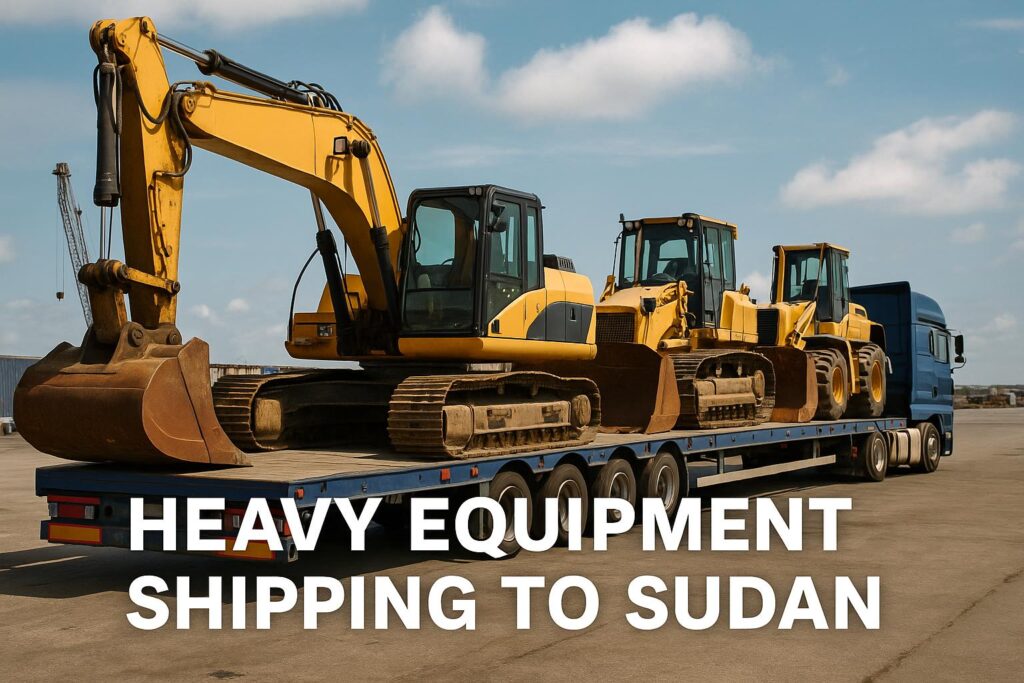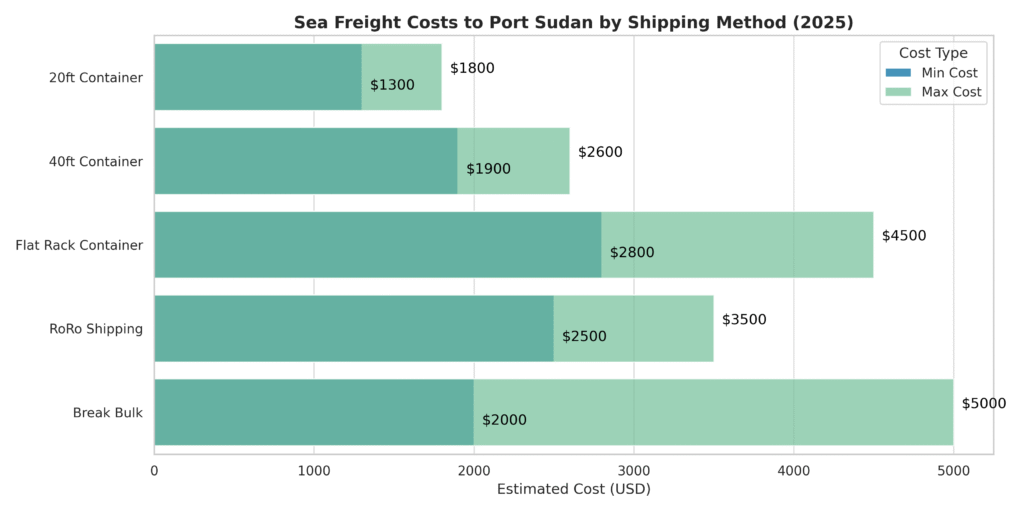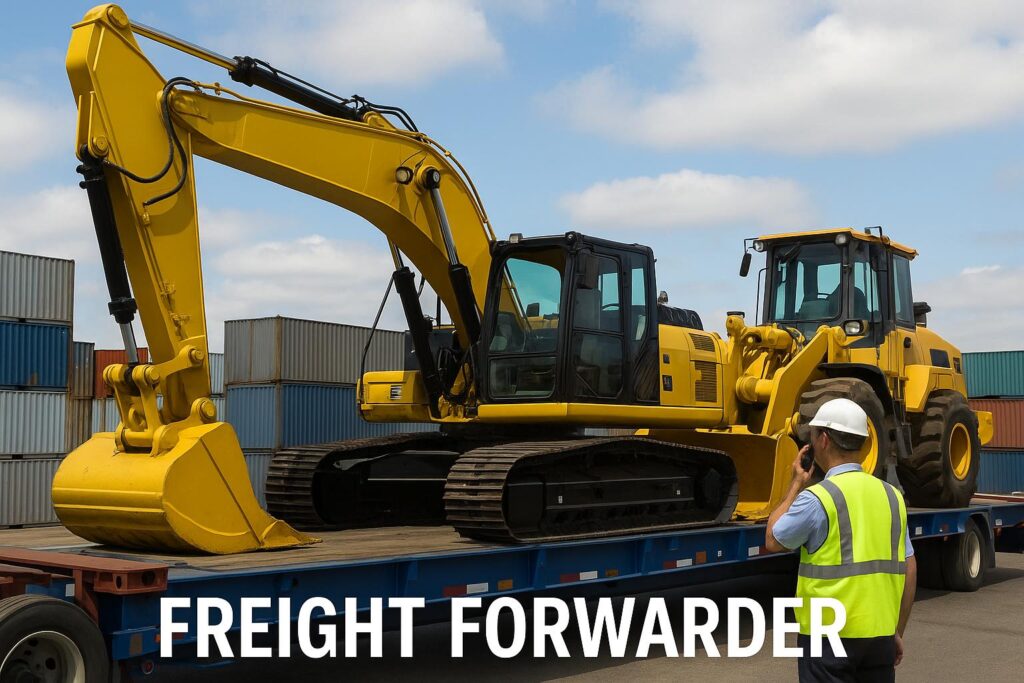Introduction: Reliable Heavy Equipment Shipping to Sudan
Shipping heavy equipment to Sudan has become increasingly essential for companies involved in construction, agriculture, oil exploration, and mining. As Sudan continues to invest in infrastructure and industrial development, the demand for reliable international shipping solutions has surged.
Whether you’re transporting bulldozers, excavators, cranes, or other oversized machinery, selecting the right shipping method—such as flat rack shipping, RoRo (roll-on/roll-off), or break bulk shipping—is crucial. Moreover, navigating customs clearance at Port Sudan, managing documentation like the commercial invoice, and choosing a trustworthy shipping partner will directly impact your delivery timeline and overall shipping costs.
In this 2025 guide, we’ll provide expert insights into:
- Best international shipping methods for heavy equipment
- Container options and oversized cargo handling
- Transit times and cost estimates to Sudan
- Required documents and customs procedures
- Tips for working with freight forwarders and ensuring safe delivery
Let’s explore the most efficient way to ship your heavy machinery to Sudan and meet your business goals with confidence.

What Types of Heavy Equipment Are Commonly Shipped to Sudan?
Sudan’s growing economy and infrastructure development have driven consistent demand for importing various types of heavy equipment. These machines play a critical role in construction, mining, road building, agriculture, and oil-related industries.
Here’s a breakdown of the most commonly shipped machinery and cargo to Sudan:
Construction Machinery
- Excavators
- Bulldozers
- Graders
- Wheel loaders
- Concrete mixers
These are essential for real estate, road, and bridge projects across Sudan’s urban and rural regions.
Agricultural Equipment
- Tractors
- Harvesters
- Ploughs
- Irrigation machinery
Agricultural machines are shipped regularly to support farming in regions like Gezira, Sennar, and the Nile Valley.
Industrial and Mining Equipment
- Drilling rigs
- Crushers and screening plants
- Compressors
- Generators
Mining and energy projects rely on specialized industrial machinery, often classified as oversized cargo due to their non-standard dimensions.
Spare Parts and Attachments
- Hydraulic arms
- Buckets and blades
- Replacement parts for older machines
- Tires, filters, and electrical systems
These are often shipped as container cargo or bundled with larger units, especially for companies maintaining existing fleets.
Commercial Goods and Support Equipment
Many companies also ship related commercial goods, such as fuel tanks, mobile workshops, and storage containers to support on-site operations in remote areas.
Best Shipping Methods for Heavy Equipment to Sudan
When shipping heavy equipment to Sudan, choosing the right shipping method depends on the type, size, and weight of your machinery. The main port of entry—Port Sudan—is well equipped to handle oversized cargo, break bulk, and containerized shipments.
Below are the most reliable shipping methods for transporting large and heavy machinery from China, the USA, Europe, or other regions to Sudan:
RoRo (Roll-On/Roll-Off) Shipping
RoRo shipping is ideal for self-propelled equipment such as tractors, wheel loaders, graders, and trucks. Machinery is driven directly onto the vessel and secured on a protected deck.
Advantages:
- Fast loading and unloading
- No need for disassembly
- Lower risk of damage from crane lifting
Limitations:
- Only suitable for rolling equipment
- Limited space for oversized or irregular-shaped cargo
Flat Rack Shipping
Flat rack containers are open-sided, making them ideal for oversized equipment that doesn’t fit in standard containers. They’re frequently used to transport items like excavators, cranes, and large compressors.
Advantages:
- Perfect for tall or wide machinery
- Allows easy crane loading at both origin and destination
Limitations:
- Higher cost than standard containers
- Requires precise securing and packaging to ensure safety
Break Bulk Shipping
For extremely heavy, irregular, or non-containerized cargo, break bulk shipping is often the best option. Equipment is loaded individually, piece by piece, onto the vessel deck.
Common for:
- Industrial drilling equipment
- Large engines or turbines
- Disassembled parts of cranes or plants
Considerations:
- Longer handling time
- May require additional documentation and permits
Standard Container Shipping
Some smaller items like spare parts, attachments, or compact machinery may fit inside standard 20ft or 40ft containers. This is often the most cost-effective option for lighter commercial goods.
Each of these methods serves different needs, and a professional freight forwarder will help you assess your cargo dimensions and recommend the most efficient and cost-effective shipping solution.
Shipping Routes and Transit Times to Port Sudan
Choosing the right shipping route is essential for achieving timely delivery and cost efficiency when shipping heavy equipment to Sudan. The main arrival point for international cargo is Port Sudan, located on the Red Sea, which serves as Sudan’s largest and busiest seaport.
Common Shipping Routes to Port Sudan
From China:
- Route: Shanghai / Ningbo / Qingdao → Jeddah (transit) → Port Sudan
- Mode: Sea Freight (Flat Rack / RoRo / Break Bulk)
- Transit Time: 25–35 days
From Europe (Germany, Netherlands, Italy):
- Route: Hamburg / Rotterdam / Genoa → Suez Canal → Port Sudan
- Mode: Sea Freight
- Transit Time: 18–28 days
From the USA (East Coast):
- Route: New York / Savannah / Houston → Mediterranean hub → Suez → Port Sudan
- Mode: Sea Freight
- Transit Time: 30–40 days
From the UAE / Middle East:
- Route: Jebel Ali (Dubai) → Port Sudan
- Mode: Sea Freight or Air Freight for smaller loads
- Transit Time: 5–12 days (depending on service)
Air Freight Option (For Urgent Machinery or Spare Parts)
Air freight is occasionally used for urgent spare parts, compact industrial equipment, or high-value machinery.
- Departure Airports: Guangzhou, Shanghai, Dubai
- Arrival Airport: Khartoum International Airport
- Transit Time: 3–7 days
- Note: Air freight is significantly more expensive than sea freight and generally used for critical or lightweight cargo.
Transit times may vary depending on carrier schedules, seasonal demand, weather conditions, and port congestion. To ensure efficient delivery, it’s best to work with an experienced freight forwarder who understands the logistics challenges in East Africa and can help avoid delays.
Estimated Shipping Costs for Heavy Equipment to Sudan
The cost of shipping heavy equipment to Sudan can vary widely based on the size and weight of the machinery, the shipping method, origin port, and the final destination within Sudan. Understanding these costs upfront helps importers budget more accurately and avoid delays or unexpected fees.
Below is a breakdown of the estimated freight rates for common shipping methods to Port Sudan:
Sea Freight Costs (Port-to-Port to Port Sudan)
| Shipping Method | Cargo Type | Route Example (from) | Estimated Cost (USD) |
|---|---|---|---|
| 20ft Container | Small machines/spare parts | Ningbo – Port Sudan | $1,300 – $1,800 |
| 40ft Container | Mid-size compact equipment | Shanghai – Port Sudan | $1,900 – $2,600 |
| Flat Rack Container | Oversized construction units | Qingdao – Port Sudan | $2,800 – $4,500+ |
| RoRo Shipping | Wheeled machines (tractors) | Jebel Ali – Port Sudan | $2,500 – $3,500 |
| Break Bulk | Extremely large or heavy gear | Tian jin – Port Sudan | $2,000 – $5,000+ |
Note: Costs vary depending on cargo dimensions, weight, and fuel surcharges. Oversized cargo or equipment requiring escort/loading assistance may incur extra charges.

Air Freight Costs (For Urgent or Lightweight Items)
| Weight Bracket | Example Item | Estimated Air Freight Rate (USD/kg) |
|---|---|---|
| 100–300 kg | Small generator, pump | $5.50 – $8.00 |
| 300–1000 kg | Engine block, parts kit | $4.00 – $6.50 |
| Over 1000 kg | Compressors, mini rigs | Quote required (cargo-specific) |
Air freight is often used for critical parts or fast-response projects, not full-size machines due to high cost per kilogram.
Other Potential Charges to Consider
- Customs duties & taxes in Sudan
- Port handling & unloading fees
- Inland transportation (e.g., Port Sudan to Khartoum or mining sites)
- Packaging and loading charges (especially for flat rack/break bulk)
To get the most cost-effective pricing, it’s recommended to:
- Ship in full container loads when possible
- Consolidate spare parts
- Book space in advance, especially during peak seasons
- Work with a reliable freight forwarder experienced in East African routes
Customs Clearance and Import Regulations in Sudan
Successfully shipping heavy equipment to Sudan doesn’t end at the port—navigating customs clearance procedures is a critical step. Delays, fines, or even confiscation can occur if documents are incomplete or local import regulations aren’t followed properly.
Here’s what you need to know about clearing heavy equipment through Sudan customs:
Required Documentation
Make sure you prepare the following documents in advance. These are mandatory for all international shipments to Port Sudan:
- Bill of Lading (B/L) – Confirms ownership and shipping method
- Commercial Invoice – Includes full cargo value, HS codes, and exporter/importer details
- Packing List – Describes each item, dimensions, and weight
- Certificate of Origin – Especially required for goods claiming tariff exemptions
- Import Permit – Certain machines require approval from Sudanese authorities
- Insurance Certificate – Strongly recommended for high-value cargo
- Inspection Certificate – May be required for used or refurbished machinery
Sudanese Customs Clearance Process
- Pre-arrival documentation submission (via customs broker or freight forwarder)
- Cargo inspection at Port Sudan – May include physical inspection or document verification
- Duties and taxes assessment – Based on declared value and HS code
- Release order issued – Upon successful payment and approval
- Inland transport – To final destination in Sudan (Khartoum, Nyala, Atbara, etc.)
Tips to Expedite Customs Clearance
- Ensure all documents are complete, consistent, and signed
- Work with a local customs broker familiar with Sudanese procedures
- Avoid under-declaring values—this can trigger fines and investigations
- If shipping used equipment, include condition reports or refurbishment certificates
- Ask your freight forwarder if pre-clearance is possible before cargo arrives
By planning ahead and preparing proper documentation, you can avoid unnecessary delays and ensure your heavy equipment shipment arrives smoothly in Sudan.
How to Choose the Right Freight Forwarder for Sudan-bound Machinery
Selecting a reliable freight forwarder is one of the most important decisions you’ll make when shipping heavy equipment to Sudan. The right shipping partner not only manages the transport itself but also helps navigate the logistical challenges, documentation, and customs clearance procedures in East Africa.
Here’s what to look for in a trusted freight forwarder:
Experience in Heavy Equipment Logistics
Make sure your forwarder specializes in handling oversized cargo, flat rack shipments, and break bulk equipment. Experience with construction machinery, cranes, and mining rigs is a major advantage.
Familiarity with Port Sudan Operations
Your forwarder should understand the customs system and port infrastructure in Port Sudan, including:
- Local handling agents
- Customs regulations
- Port unloading procedures
- Inland delivery coordination
Customs Clearance Support
Look for companies that offer end-to-end solutions, including:
- Documentation preparation
- HS code classification
- Duty/tax calculation
- On-site customs clearance at Port Sudan
Transparent Pricing & Route Options
A trustworthy partner provides:
- Detailed cost breakdowns (freight + port fees + inland delivery)
- Multiple route options (e.g., RoRo vs flat rack)
- Clear transit time estimates
- No hidden fees
Value-Added Services
Some freight forwarders also offer:
- Equipment dismantling/reassembly
- Cargo insurance
- Temporary warehousing
- Spare parts consolidation
Customer Reviews and Global Network
Check online reviews or ask for customer references. Forwarders with strong networks in China, UAE, Europe, and Sudan are often more capable of handling complex cross-border projects.
A professional freight forwarder becomes your logistical partner—from loading at origin to final delivery across Sudan. They ensure your cargo is transported safely, efficiently, and with utmost care, regardless of its size or destination.

Step-by-Step Shipping Process: From Factory to Port Sudan
To ensure a smooth and secure shipment of heavy equipment to Sudan, importers and contractors must follow a well-planned shipping workflow. Here is the step-by-step process for transporting heavy machinery from the origin country (such as China, the UAE, or Europe) to Port Sudan:
Step 1: Equipment Preparation and Packing
- Clean and inspect machinery
- Remove detachable parts (for flat rack or break bulk shipping)
- Apply anti-corrosion treatment for sea voyage
- Reinforce with blocks, straps, and protective covers
For container shipping, the equipment must fit within standard size limits (e.g., 20ft or 40ft containers)
Step 2: Documentation & Booking
- Prepare all required shipping documents (Commercial Invoice, Packing List, B/L, Certificate of Origin, etc.)
- Select the appropriate shipping method: RoRo, Flat Rack, Break Bulk, or Container
- Book space with the freight forwarder or carrier
Step 3: Inland Transport to Port of Loading
- Transport equipment from factory to seaport (e.g., Shanghai, Jebel Ali, Rotterdam)
- Use low-bed trailers or special trucks for oversized cargo
- Ensure customs documents are ready before departure
Step 4: Ocean Freight Shipping
- Cargo is loaded on vessel:
- Rolled on (RoRo)
- Lifted onto flat rack or break bulk deck
- Stuffed into containers if possible
- Vessel departs for Port Sudan, usually via Suez Canal
Step 5: Port Sudan Arrival & Unloading
- Cargo is offloaded at Port Sudan
- Sudanese customs conducts inspection and document verification
- Duties, taxes, and port handling fees are paid
Step 6: Inland Delivery (Optional)
- Arrange truck transport to final site (e.g., Khartoum, El-Obeid, Atbara)
- Use specialized trailers for heavy/long equipment
- Ensure secure and timely unloading at the site
A professional freight forwarder will coordinate each step for seamless transportation, from pickup to final delivery.
Final Tips & Get a Freight Quote to Sudan
Shipping heavy equipment to Sudan involves more than just booking a vessel—it’s a complex process that requires coordination, documentation, and deep knowledge of logistics. Whether you’re transporting oversized machinery, industrial components, or construction equipment, working with an experienced freight forwarder can help you avoid costly mistakes and delays.
Here are a few final tips to ensure your shipment arrives safely and on time:
Plan Ahead
Shipping schedules and freight rates can fluctuate due to seasonal demand, fuel prices, or carrier availability. Always book your shipment in advance to lock in cost-effective pricing.
Know Your Dimensions
Accurate measurement of your cargo’s size and weight is crucial for choosing the right shipping method—whether it’s flat rack, RoRo, or break bulk. Use a CBM calculator to get exact volume and chargeable weight.
Consolidate When Possible
If shipping spare parts or multiple smaller machines, consolidating them into a single container can save significantly on shipping costs.
Verify Sudanese Import Requirements
Customs clearance at Port Sudan requires specific documents. Double-check all requirements and obtain necessary import permits before departure.
Ready to Ship Heavy Equipment to Sudan?
Whether you’re sourcing from China, UAE, Europe, or elsewhere, we offer full-service solutions for heavy equipment shipping to Sudan, including:
- RoRo and flat rack transport
- Container loading and securing
- Customs clearance and documentation
- Port Sudan delivery
- Spare parts consolidation
Get a personalized freight quote now — Our logistics experts will help you find the most efficient and reliable shipping solution based on your cargo size, budget, and delivery timeline.


